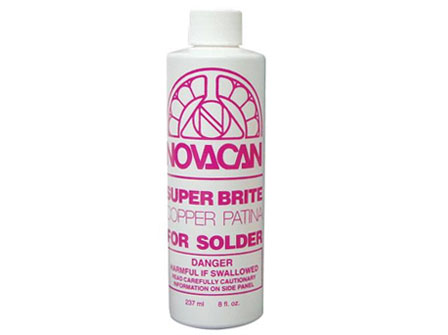


Then add a small amount of liver of sulfur (nuggets or gel) to the cup. To speed up the process, soak your jewelry in a cup of warm water until the piece is warm too. One drop of water can ruin the whole batch. If you prefer to use the nuggets, be sure to store the container in a dry place. The liquid has a longer shelf life and fewer harmful chemicals. Liver of sulfur comes as small nuggets or a gel-like liquid. This method uses the same combo - heat and liver of sulfur.
#Chemical patina copper plus
Liver of SulfurĮver go into a hot spring wearing a bright silver bracelet and come out with a dark band around your wrist instead? It was probably the sulfur in the water plus the heat that changed the color. Seal it with beeswax or an acrylic clear coat and you’re good to go. If you’d rather have a lighter hue, take steel wool to your piece of jewelry and remove some of the patina.
#Chemical patina copper pro
Pro Tip: Let the color go a little longer than you might like, as this patina has a tendency to flake off. You’re most likely to see turquoise, blue and green but you really can’t predict what you’ll get! Then check back every few hours or so to see what colors come through. You can sprinkle a little more salt on the top if you’d like to speed things along. Then remove it, place it on a paper towel and let it air-dry. Let the jewelry soak for at least a half hour. Just keep the 1:1 ratio of vinegar to salt the same. If you have a bigger piece of jewelry, you’ll need more liquid to cover the piece completely. Three tablespoons of each are enough for a small pendant. Stir until the salt dissolves into the vinegar. Hey, kitchen magician! All you need for this technique are equal amounts of vinegar and salt. Acrylic clear coats, beeswax or renaissance waxes can help protect the surface and the color. When you’ve hit upon a shade you love, add a sealant to finish it off. Experiment and see what color works best for your piece. Pro Tip: Heating copper can result in drastic color changes to avoid this, pull the torch away slowly.

Try not to get too attached to a particular tint until you get the hang of this technique, because a bright reddish tint (for instance) might quickly fade into a bluish tone. The key is to stop before you’ve gone too far. Heat PatinaĪs you heat copper with a torch, it starts to change color, turning different shades of bright red, purple and blue. Now it’s go time! 3 Ways to Patina Copper 1. Your piece will not only have a more satiny finish but when you do add a patina, it will have more surface to work on.Īfter you finish, handle the jewelry by its edges so you don’t transfer any oils back onto it. If you don’t, grab a scrubbing sponge (like Scotch-Brite) and gently scuff the surface. (That means no fingerprints!) If you have a pickle pot, this is a great time to get it out.
#Chemical patina copper free
To get the best results, prep your pieces first so they’re free from dirt and oil. Try ’em all and see which method you like best. You can patina your copper pieces three different ways, each resulting in a different look. If you’re looking to add dimension to your handmade copper jewelry, it’s a super fun technique to explore that’s a little wilder than the usual matte, shiny or brushed looks. The links below will take you to pages with many large samples of particular families of patina, and descriptions of how the patinas are made.Patina is the blueish-greenish layer on the surface of copper that comes from age or chemicals (we see you, Statue of Liberty!). Also see the pages on individual patinas and their techniques linked below. Our Links page lists a couple of chemical suppliers who also provide pre-mixed patinas and have patina formulas on their sites. If you found this page looking for more information on patination for your own projects in copper, brass, or bronze, check out our Bibliography for patina books, our Patina Safety page, our Patina Formulas (to be used at your own risk), and our page on Patina Technique (under construction). If you are interested in commissioning a wallpiece, you should consider getting a book of samples of our most popular patinas. Keep in mind, pictures in these pages can provide only a limited idea of the actual look and feel of the patinas. Use the links below to view large swatches of different patinas. Often, the final patina is a result of two or more different patinas layered one over another. Others are formed over several days by burying the piece in wood chips soaked with other patina chemicals. Most of our patinas are achieved by brushing chemical solutions onto the surface of the brass while heating that surface with an oxyacetylene torch. Our patinas, like most sculptural patinas, are made by mixing chemicals and applying them to the surface, rather than waiting for nature to take its course. Patinas are formed by chemical reactions on the surface of metals.


 0 kommentar(er)
0 kommentar(er)
